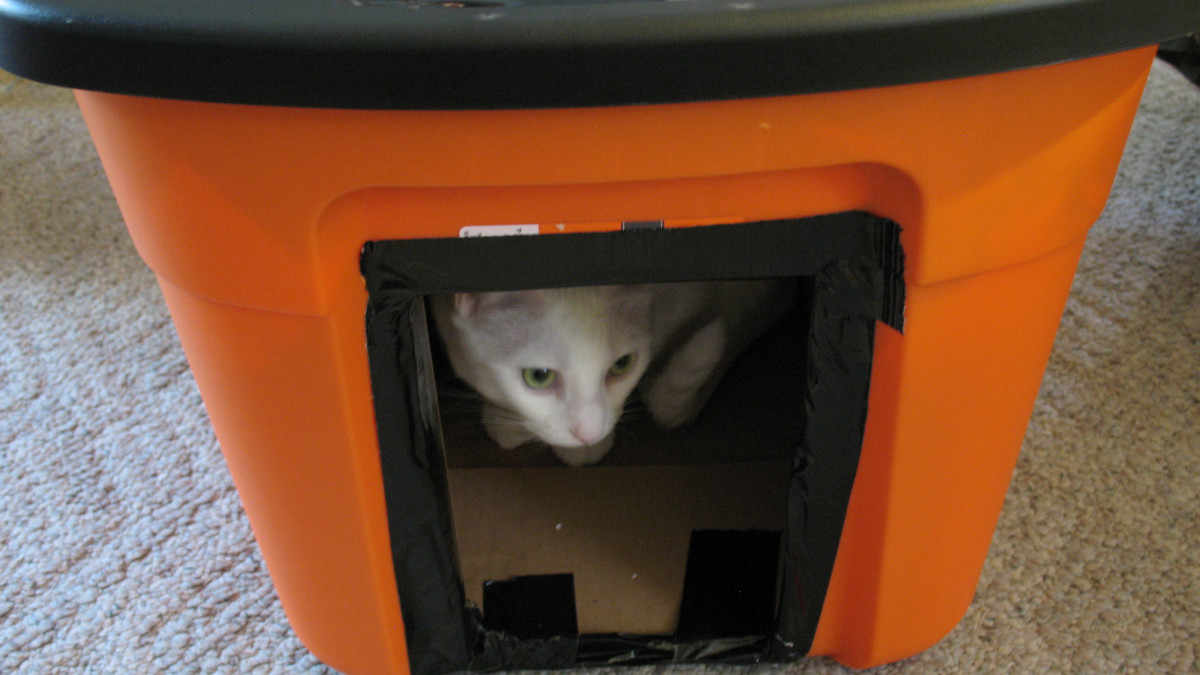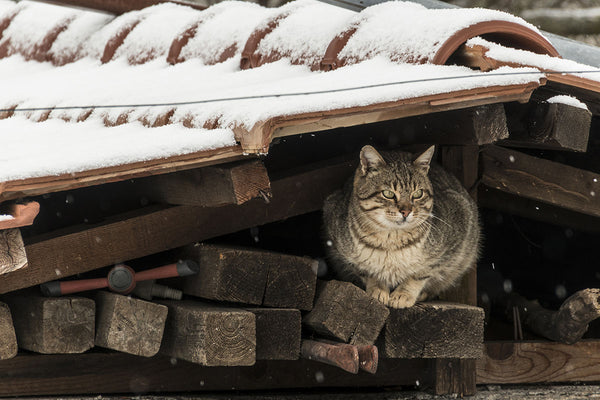When winter arrives, stray cats face harsh cold and danger every day. You might see a shivering cat outside and wonder how you can make a difference.
Helping a stray cat in winter is easier than you think, and your small actions can save a life. You will discover simple, effective ways to keep a stray cat warm, safe, and cared for during the cold months. Keep reading, because your kindness could be the warmth a stray cat desperately needs right now.
Signs A Stray Cat Needs Help
Recognizing the signs that a stray cat needs help in winter is important. Cold weather makes survival hard for these animals. Not all stray cats show clear signs of distress. Watch closely for changes in behavior, physical health, and their surroundings. These clues can guide you to offer timely help.
Behavioral Clues
- Cat appears unusually tired or weak
- Moves slowly or limps
- Hides in unsafe or exposed places
- Seeks shelter near human homes or cars
- Shows signs of distress or agitation
- Excessive meowing or crying for attention
Physical Indicators
- Visible wounds or infections on body
- Thinning fur or bald patches
- Weight loss or thin appearance
- Shivering or trembling
- Dirty or matted fur
- Swollen eyes or nose discharge
Environmental Risks
- Cat exposed to cold wind or rain
- No visible shelter or hiding spot nearby
- Near busy roads or dangerous areas
- Snow or ice covering usual resting places
- Signs of frostbite on ears, paws, or tail
- Frequent visits to trash or unsafe food sources

Credit: www.amazon.ca
Safe Shelter Options
Providing a safe shelter for stray cats during winter is critical. Cold weather can be harsh and dangerous for cats living outdoors. A warm, dry, and secure place helps them survive freezing temperatures. Simple shelters can make a big difference in their health and safety. Consider easy ways to create or find a shelter that keeps cats protected from wind, rain, and snow.
Diy Shelter Ideas
Build a shelter using materials you have at home. A plastic storage bin or large cooler works well. Cut a small entrance just big enough for a cat. Add a flap made from heavy plastic or fabric to block cold air. Line the inside with straw for warmth. Avoid blankets or towels because they hold moisture. You can also use a wooden box with a raised floor to keep cats off the cold ground. Make sure the shelter is sturdy and waterproof.
Choosing The Right Location
Place the shelter in a quiet, hidden spot away from busy areas. Near a building or fence provides extra wind protection. Avoid open spaces where wind and snow can reach easily. Look for spots that get some sun during the day to add warmth. Keep the entrance facing away from prevailing winds. Check regularly to ensure the shelter remains safe and clean.
Insulation And Warmth Tips
- Use straw inside the shelter. It traps heat and stays dry.
- Add a layer of foam or bubble wrap under the shelter to block cold from the ground.
- Cover the shelter with a tarp or heavy plastic to keep rain and snow out.
- Place old towels or blankets outside the entrance to reduce wind.
- Check the shelter often and replace damp materials immediately.
Feeding Stray Cats In Winter
Feeding stray cats during winter is more than just offering a meal; it’s about providing the right kind of nourishment that helps them survive harsh conditions. Cold weather increases a cat’s energy needs, so what you offer can make a real difference. Have you noticed how much more your own pet eats in winter? Strays need that boost even more.
Nutritious Food Choices
Stray cats need food that gives them energy and warmth. Wet cat food is excellent because it contains moisture and nutrients, but dry kibble can be left outside longer without freezing. You can mix both to offer variety and keep their diet balanced.
Look for foods high in protein and fat—these give cats the calories they burn to stay warm. Avoid bread or milk, which can upset their stomachs. Canned tuna or chicken can work in emergencies but shouldn’t replace proper cat food regularly.
Feeding Schedule
Consistency helps stray cats trust you and keeps them coming back. Try to feed them at the same times every day, ideally twice—once in the morning and once in the evening. This routine supports their metabolism and helps them maintain energy levels through cold nights.
If you can’t feed daily, leaving enough food to last until your next visit is crucial. However, avoid overfeeding all at once, as leftover food can freeze or attract unwanted pests. Have you considered how your feeding habits impact the local stray cat population?
Water Provision And Prevention Of Freezing
Water is as important as food, especially in winter when dehydration is a risk. Stray cats may avoid frozen water, so providing fresh water regularly is key. Using shallow bowls and changing water frequently can prevent freezing.
You can also use heated water bowls or place water dishes in sheltered areas to keep them from freezing. Even a small amount of warmth makes a big difference in keeping water accessible. Have you tried simple tricks like adding a ping pong ball to the water bowl to reduce ice formation?

Credit: bestfriends.org
Health And Safety Precautions
Caring for a stray cat during winter requires more than just providing food and shelter. Health and safety precautions are crucial to protect these vulnerable animals from harsh weather and hidden dangers. Your awareness and careful actions can make a big difference in their survival and well-being.
Avoiding Hypothermia
Hypothermia is a real threat to stray cats in cold weather. You can help by offering insulated shelter that blocks wind and retains heat. Adding blankets or straw inside the shelter creates warmth without moisture buildup.
Keep in mind that wet fur accelerates heat loss. Check the cat’s fur for dampness and gently dry it if possible. Have you noticed how quickly small animals shiver? That’s a warning sign hypothermia may be setting in.
Handling And Approach Tips
Stray cats are often scared and defensive, especially in winter when they feel vulnerable. Approach slowly and calmly, avoiding sudden movements or loud noises. Speak softly to gain trust before attempting to touch or pick up the cat.
Use a towel or blanket to gently wrap the cat if you need to move it, protecting yourself and reducing its stress. Have you tried offering food first? This simple gesture often makes the cat more comfortable with your presence.
When To Seek Veterinary Care
Some health issues require immediate attention. Look out for signs like persistent shivering, lethargy, wounds, or difficulty breathing. If the cat appears weak or has visible injuries, it’s time to contact a vet.
Even minor cuts can get infected quickly in cold conditions. You might wonder if the cat needs a check-up despite seeming okay—trust your instincts. Early veterinary care can prevent serious complications later on.
Long-term Support Strategies
Providing long-term support to stray cats during winter goes beyond offering immediate warmth and food. It requires thoughtful strategies that help reduce the stray population and improve their living conditions sustainably. These approaches not only protect the cats but also benefit your entire community.
Trap-neuter-return (tnr) Programs
TNR programs are a proven way to control stray cat populations humanely. You trap the cats, get them neutered or spayed, and then return them to their original location. This prevents more kittens from being born and gradually reduces the number of strays over time.
Participating in or organizing a TNR program lets you directly impact the stray cat community. It also improves their health because neutered cats are less likely to roam, fight, or spread diseases. Have you ever considered how a small action like this can create lasting change?
Building Community Awareness
Educating your neighbors about stray cats and their needs can spark collective action. You can share tips on providing shelter, feeding responsibly, and why TNR matters. Awareness encourages people to be part of the solution instead of ignoring the problem.
Try organizing local meetups or sharing stories on social media to keep the conversation alive. The more people understand, the more help the strays will get. What would happen if everyone in your area took just one small step to support these cats?
Connecting With Local Animal Services
Local shelters and animal welfare groups often have resources and expertise that can make your efforts more effective. Reach out to them for advice, supplies, or to report cats in urgent need. They might also have volunteer programs you can join.
Building these connections creates a support network that benefits both you and the cats. It ensures help is available during emergencies and provides options beyond what one person can do alone. Have you checked which organizations near you are ready to assist stray cats this winter?

Credit: pethelpful.com
Frequently Asked Questions
How Can I Provide Shelter For A Stray Cat In Winter?
You can offer a warm, insulated shelter using a sturdy box with blankets. Place it in a safe, dry, and quiet spot to protect the cat from cold and wind.
What Food Is Best For Stray Cats During Winter?
High-calorie, protein-rich food helps stray cats maintain energy. Wet food is ideal, but dry food works if kept dry. Fresh water should always be available and unfrozen.
How Do I Keep Water From Freezing For Stray Cats?
Use heated water bowls or change water frequently to prevent freezing. Place bowls in sheltered areas and use warm water to encourage drinking.
Should I Try To Trap And Bring A Stray Cat Indoors?
If safe, trapping and bringing a cat indoors can protect it from harsh weather. Use humane traps and consult local shelters for advice and support.
Conclusion
Caring for stray cats during winter is truly rewarding. Simple actions can save lives. Provide shelter, food, and water. Check local shelters for help. Your kindness makes a big difference. Stray cats need warmth and safety. Small efforts can create huge impacts.
Remember, each cat deserves a chance. Be their hero in cold months. Show compassion and understanding. Together, we can help them survive winter. Your efforts can inspire others, too. Communities thrive when people care. Spread warmth and love this winter season.
Cats will thank you with purrs and affection. Let’s make the world a kinder place.





